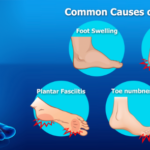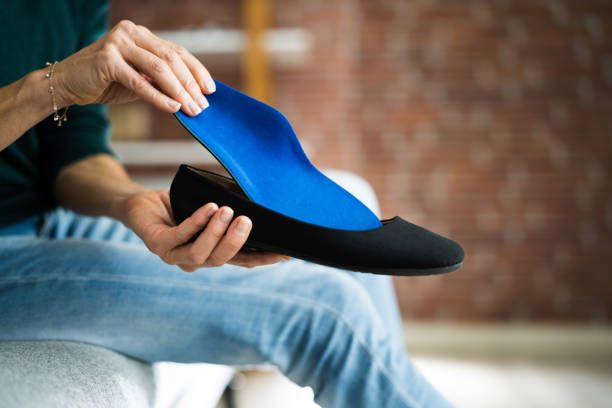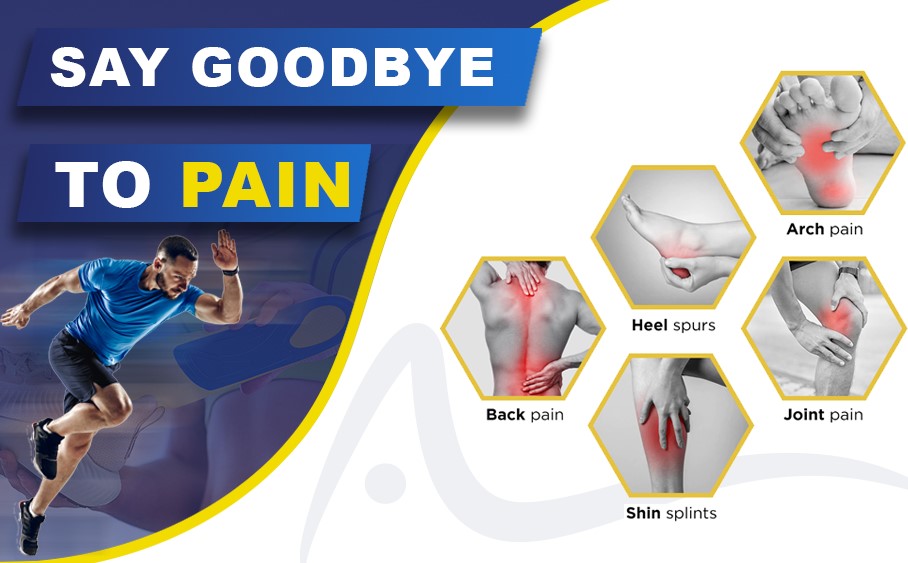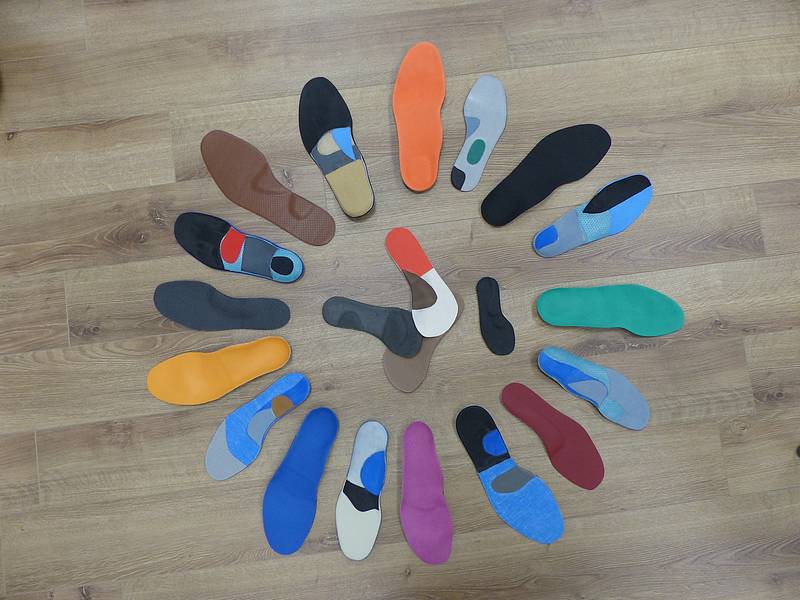Plantar fasciitis can be an excruciating condition, impacting mobility and causing immense discomfort. It’s a prevalent issue affecting many, but the right support can make a significant difference. Orthopedic insoles emerge as a promising solution, offering relief and aiding in the management of this condition.
Introduction to Plantar Fasciitis
Plantar Fasciitis is a common foot condition characterized by inflammation in the plantar fascia, a band of tissue that connects the heel bone to the toes. This inflammation causes persistent pain, usually felt as a stabbing sensation, primarily in the heel area or the underside of the foot. Individuals often experience heightened discomfort after prolonged periods of rest, such as when waking up in the morning or after sitting for an extended duration.
The condition typically arises from repetitive strain or excessive pressure on the plantar fascia. Engaging in activities that involve repetitive stress on the feet, wearing shoes with inadequate support, or having certain foot structures that affect weight distribution can contribute to this inflammation.
Addressing Plantar Fasciitis requires understanding the importance of proper foot support. The lack of adequate arch support can lead to abnormal stretching and straining of the plantar fascia, exacerbating the condition. Consequently, individuals with this ailment often seek solutions to alleviate pain and facilitate healing.
Orthopedic insoles, also known as orthotics, play a significant role in managing Plantar Fasciitis. These insoles are designed to provide support, cushioning, and alignment to the feet. By redistributing pressure, correcting foot mechanics, and reducing strain on the plantar fascia, they aim to alleviate discomfort and aid in the recovery process.
Choosing the right orthopedic insoles involves considering various factors, including arch type, foot shape, level of cushioning, and the severity of the condition. Whether opting for over-the-counter inserts or custom-made ones, finding insoles that fit properly and offer comfort is essential for effective support and pain relief.
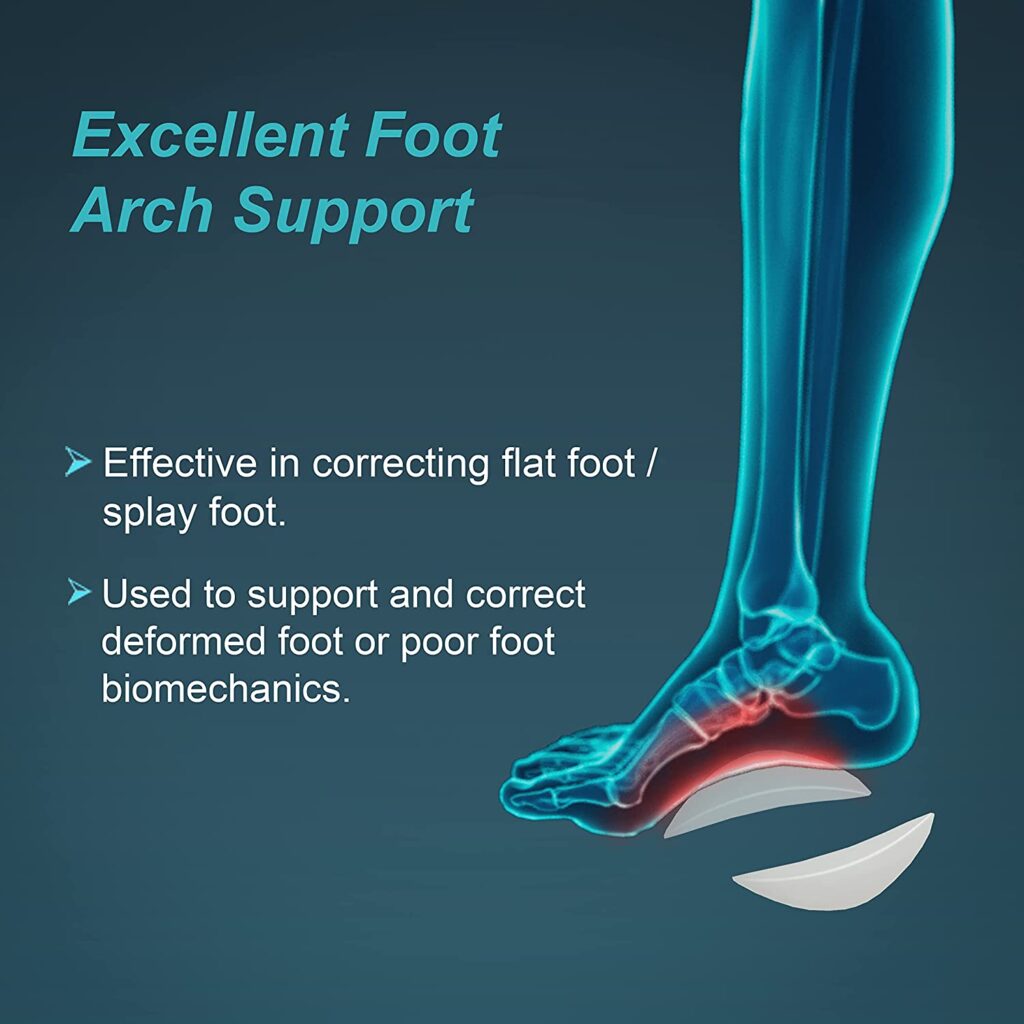
Understanding Orthopedic Insoles
Understanding Orthopedic Insoles is essential in addressing Plantar Fasciitis. These specialized inserts, also called orthotics, are designed to provide additional support, stability, and cushioning to the feet. They play a crucial role in alleviating discomfort caused by Plantar Fasciitis by offering targeted support to the arches and heels.
Orthopedic insoles work by redistributing pressure across the foot, thereby reducing strain on the plantar fascia—a key factor in managing the condition. They aim to correct improper foot mechanics and promote proper alignment, easing the pain associated with Plantar Fasciitis.
These insoles come in various types, ranging from off-the-shelf options available at pharmacies or shoe stores to custom-made ones prescribed by podiatrists or healthcare professionals. The choice between them often depends on the individual’s specific foot structure, severity of the condition, and the level of support required.
These inserts are typically made from materials that provide cushioning and support to different areas of the foot. Some might have extra padding in the heel or arch area, while others might offer a more uniform cushioning throughout the footbed.
Understanding how Orthopedic Insoles function and their varying types is crucial in selecting the most suitable option to effectively manage Plantar Fasciitis and alleviate discomfort in everyday activities.
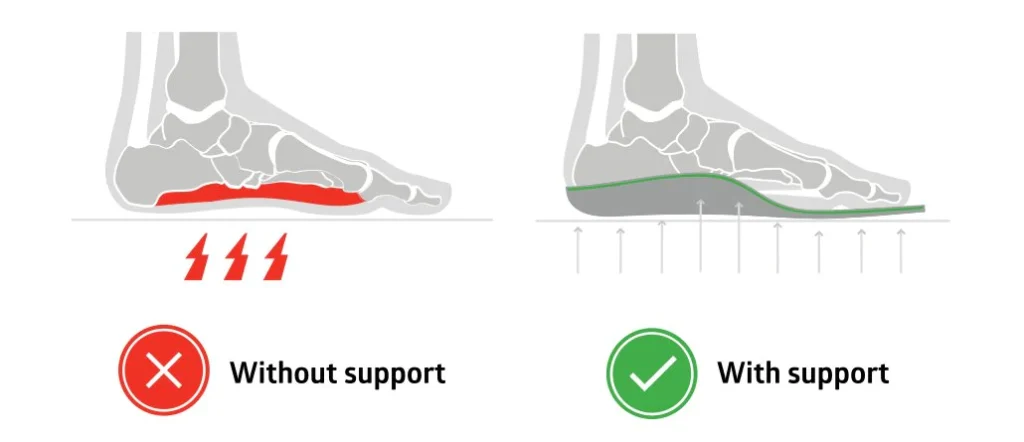
Types of Orthopedic Insoles
- Over-the-Counter Insoles: These are readily available at pharmacies or shoe stores without a prescription. They offer standardized support and are cost-effective. While they provide general relief, they might not cater to individual foot shapes or conditions as precisely as custom-made insoles.
- Custom-Made Insoles: These are crafted based on individual foot measurements and prescribed by healthcare professionals. Custom insoles offer personalized support, addressing specific foot issues or irregularities. They provide a higher level of comfort and support compared to off-the-shelf options.
- Rigid Orthotics: Primarily made from harder materials like plastic or carbon fiber, these insoles are suitable for controlling foot motion in cases of abnormal foot mechanics. They are often used to alleviate pain in the legs, thighs, or lower back caused by improper foot alignment.
- Soft Orthotics: These insoles are crafted from softer materials like foam or gel to provide cushioning and support. They’re beneficial for reducing pressure on sensitive areas, offering extra comfort, and absorbing shock during activities.
- Semi-Rigid Orthotics: Combining aspects of both rigid and soft orthotics, these inserts offer stability, support, and cushioning. They are suitable for addressing various foot issues and supporting a range of activities while maintaining a balance between
Benefits of Orthopedic Insoles for Plantar Fasciitis
- Targeted Support and Pressure Redistribution: Orthopedic insoles are specifically designed to support the arch of the foot, which is crucial in alleviating plantar fasciitis discomfort. By providing targeted support, these insoles help to redistribute pressure evenly across the foot, reducing strain on the ligaments and easing inflammation.
- Shock Absorption and Stability: One of the key advantages of orthopedic insoles is their ability to absorb shock. This feature not only cushions the foot but also enhances stability during walking, running, or engaging in various physical activities. This shock-absorbing quality significantly reduces the impact on the feet, lessening discomfort caused by plantar fasciitis.
- Correction of Biomechanical Imbalances: Beyond pain relief, orthopedic insoles address biomechanical issues contributing to plantar fasciitis. They aid in correcting irregularities in foot alignment, which can be a root cause of the condition. By promoting proper alignment, these insoles mitigate strain on the plantar fascia, facilitating the healing process.
- Customized Support for Different Needs: Orthopedic insoles come in various types and designs, catering to different foot types and activity levels. Some are designed for specific foot arch types, offering tailored support. Additionally, there are options suited for various activities like running or standing for extended periods, ensuring that individuals get the support they need for their specific lifestyle.
- Enhanced Mobility and Quality of Life: Individuals suffering from plantar fasciitis often experience limited mobility and persistent discomfort. Orthopedic insoles not only alleviate pain but also enhance overall mobility. Many users report an improved quality of life, as these insoles enable them to move more comfortably and confidently, reducing the impact of plantar fasciitis on daily activities.
In summary, orthopedic insoles provide multifaceted benefits, including targeted support, shock absorption, correction of biomechanical issues, customization for different needs, and an overall improvement in mobility and quality of life for individuals coping with plantar fasciitis.
Choosing the Right Orthopedic Insoles
- Foot Arch Type Assessment: Understanding your foot arch type is vital. The Atlas Arch Support, among various options, caters to different arch structures—high, medium, or low arches. Assessing your arch type helps in selecting the appropriate level of support needed.
- Support and Cushioning: The Atlas Arch Support, renowned for its adaptability and support, offers cushioning precisely where it’s required. The insoles provide targeted support to the arch, relieving pressure and offering comfort, especially for individuals dealing with plantar fasciitis.
- Customization and Compatibility: These orthopedic insoles, including the Atlas Arch Support, often come with customization features. They might be trimmable to fit different shoe sizes and shapes, ensuring compatibility with a wide range of footwear—from athletic shoes to casual wear.
- Alignment and Stability: The Atlas Arch Support, like other quality orthopedic insoles, aids in aligning the foot properly. It encourages a more stable gait by correcting any biomechanical imbalances that could contribute to or exacerbate plantar fasciitis.
- Activity-Specific Consideration: Depending on your lifestyle or specific activities, such as sports or standing jobs, choosing orthopedic insoles like the Atlas Arch Support designed for these purposes can significantly enhance comfort and performance.
- Consultation and Trial: Consulting with a podiatrist or footwear specialist can provide valuable insights. They can recommend suitable insoles based on your foot structure and the severity of your condition. Trying out different options, including the Atlas Arch Support, can help determine the most effective choice.
In essence, selecting orthopedic insoles like the Atlas Arch Support involves evaluating arch type, ensuring adequate support and cushioning, assessing customization and compatibility, considering alignment and stability benefits, accounting for specific activities, and seeking professional guidance to make an informed decision tailored to individual needs.
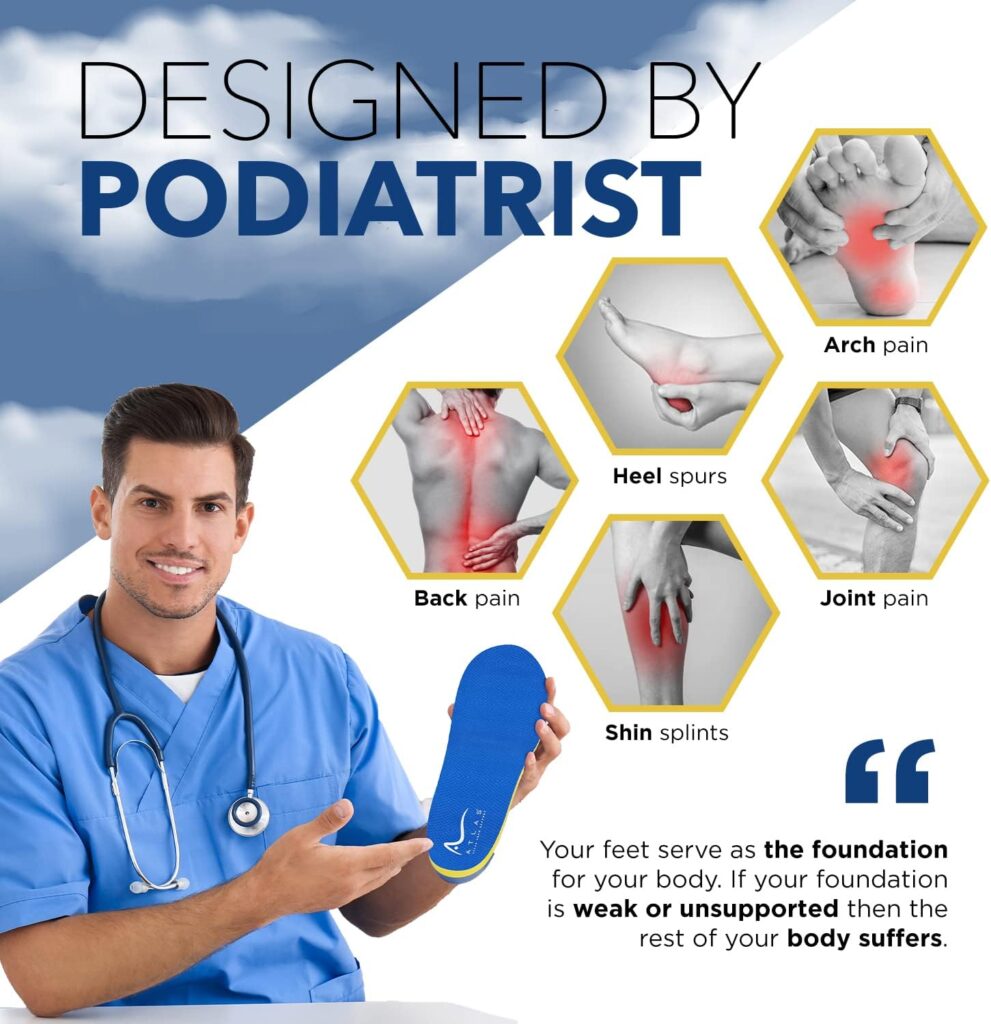
How to Use Orthopedic Insoles Effectively
- Proper Insertion: Ensure the orthopedic insoles, tailored to your foot’s needs, fit snugly inside your footwear. They should lie flat and comfortably within the shoe without causing any discomfort or altering the fit.
- Consistent Wear: For the best results, wear the orthopedic insoles consistently, especially during weight-bearing activities or times of extended standing or walking. Consistency allows your feet to adapt gradually to the support provided.
- Break-in Period: Initially, start by wearing the insoles for shorter durations to allow your feet to adjust. Gradually increase the duration of wear as your feet become accustomed to the support provided by the insoles.
- Check for Fit and Comfort: Regularly assess the fit and comfort of the orthopedic insoles. Ensure they continue to provide adequate support and cushioning without causing any discomfort, irritation, or excessive pressure points on your feet.
- Replace When Necessary: Orthopedic insoles, including the Atlas Arch Support and others, have a lifespan. Replace them as recommended by the manufacturer or when signs of wear and tear, loss of support, or reduced cushioning become noticeable.
- Combine with Proper Footwear: Pairing orthopedic insoles with supportive footwear is essential. Choose shoes that accommodate the insoles comfortably and provide additional support for your feet, enhancing the overall effectiveness of the insoles.
- Follow Professional Advice: Seek guidance from a podiatrist or footwear specialist regarding the correct usage of orthopedic insoles. They can offer personalized recommendations based on your specific foot condition and lifestyle.
By following these steps, you can effectively use orthopedic insoles, such as the Atlas Arch Support and similar options, to alleviate discomfort associated with conditions like plantar fasciitis, promoting better foot health and enhanced comfort during daily activities.
Research and Evidence Supporting Orthopedic Insoles
- Reduction in Pain: Numerous studies have demonstrated that orthopedic insoles significantly reduce pain associated with plantar fasciitis. Research published in the “Journal of Foot and Ankle Research” and the “American Journal of Physical Medicine & Rehabilitation” has shown notable decreases in heel pain and overall discomfort with the consistent use of these insoles.
- Improved Functionality: Clinical trials have indicated that orthopedic insoles improve foot functionality for individuals suffering from plantar fasciitis. They enhance foot biomechanics, leading to better gait patterns and reduced strain on the plantar fascia.
- Shock Absorption and Pressure Redistribution: Scientific evidence supports the capacity of orthopedic insoles to absorb shock and redistribute pressure evenly across the foot. Studies published in journals like “Clinical Biomechanics” and “Journal of Orthopaedic & Sports Physical Therapy” highlight their role in mitigating impact forces and reducing pressure on specific areas of the foot, aiding in the management of plantar fasciitis symptoms.
- Long-Term Benefits: Research conducted over extended periods has indicated the sustained efficacy of orthopedic insoles. Studies tracking individuals using these insoles for several months to years have reported ongoing pain relief and improved foot function, emphasizing their long-term benefits.
- Customization and Individualized Support: Evidence suggests that customized orthopedic insoles, tailored to an individual’s foot structure and biomechanics, offer superior support compared to generic insoles. Studies have indicated that personalized orthopedic solutions, like the Atlas Arch Support and similar options, lead to better outcomes in managing plantar fasciitis.
- Patient Satisfaction and Adherence: Surveys and patient-reported outcomes consistently show high levels of satisfaction and adherence to using orthopedic insoles. Users often report significant improvements in pain relief, comfort, and overall quality of life, reinforcing their effectiveness.
These findings from clinical trials, scientific studies, and patient-reported outcomes collectively support the efficacy and benefits of orthopedic insoles, providing substantial evidence for their use in managing and alleviating symptoms associated with conditions like plantar fasciitis.
Alternative Treatments for Plantar Fasciitis
- Stretching and Exercise: Specific stretching exercises targeting the calf muscles, Achilles tendon, and plantar fascia can help reduce tension and alleviate pain. Exercises such as calf stretches, towel stretches, and toe stretches aid in flexibility and promote healing.
- Physical Therapy: Working with a physical therapist can provide tailored exercises and techniques to strengthen foot muscles, improve flexibility, and correct biomechanical issues contributing to plantar fasciitis.
- Icing and Massage: Applying ice to the affected area helps reduce inflammation and pain. Additionally, massaging the foot using a tennis ball or a frozen water bottle can offer relief by loosening tight tissues and reducing tension.
- Night Splints: These devices keep the foot in a dorsiflexed position while sleeping, preventing tightening of the plantar fascia and reducing morning pain and stiffness.
- Supportive Footwear: Wearing shoes with proper arch support, cushioning, and good shock absorption can alleviate strain on the plantar fascia. Supportive footwear helps in maintaining proper foot alignment and reducing discomfort.
- Orthotic Inserts: Different from orthopedic insoles, orthotic inserts are custom-made to address specific foot irregularities and biomechanical issues. These inserts provide individualized support and can aid in managing plantar fasciitis.
- Extracorporeal Shockwave Therapy (ESWT): This non-invasive treatment involves delivering shockwaves to the affected area, promoting healing and reducing pain. It’s used for chronic cases of plantar fasciitis resistant to other treatments.
- Corticosteroid Injections: In some cases, corticosteroid injections may be recommended to alleviate severe pain and inflammation. However, their long-term effectiveness can vary, and they are typically used sparingly due to potential side effects.
- Acupuncture and Alternative Therapies: Some individuals find relief from plantar fasciitis through acupuncture, chiropractic care, or alternative therapies like ultrasound therapy or magnetic therapy. While evidence varies, some individuals report reduced pain and improved mobility.
- Lifestyle Modifications: Maintaining a healthy weight, avoiding prolonged periods of standing or walking, and ensuring adequate rest and recovery for the feet are essential in managing plantar fasciitis.
These alternative treatments can complement orthopedic insoles or be used independently to alleviate symptoms and improve the overall condition of plantar fasciitis. Consulting a healthcare professional can help determine the most suitable combination of treatments for individual cases.
Tips for Maintaining Foot Health
- Proper Footwear: Choose shoes that fit well, provide adequate support, and have cushioning. Ensure there’s enough room for your toes to move freely and avoid narrow or ill-fitting footwear that can cause discomfort or lead to foot problems.
- Regular Cleaning and Hygiene: Wash your feet daily with mild soap and warm water, ensuring to dry them thoroughly, especially between the toes. Moisturize to prevent dryness but avoid applying lotion between the toes to prevent fungal infections.
- Trim Nails Carefully: Trim toenails straight across to prevent ingrown nails. Avoid cutting them too short or rounding the edges, which can lead to painful ingrown toenails.
- Keep Feet Dry: Moisture can cause fungal infections like athlete’s foot. Wear moisture-wicking socks and change them if your feet get sweaty. Alternate your shoes to allow them to dry out fully between uses.
- Regular Foot Inspections: Check your feet regularly for any signs of redness, swelling, cuts, blisters, or sores. Early detection of issues can prevent them from worsening.
- Proper Support: Consider using orthopedic insoles or inserts to provide additional support and cushioning, especially if you have foot conditions like plantar fasciitis or flat feet.
- Foot Exercises: Perform regular exercises to strengthen the muscles in your feet and ankles. Simple movements like toe curls, ankle rotations, and picking up small objects with your toes can help maintain foot flexibility and strength.
- Maintain a Healthy Weight: Excess weight puts additional pressure on your feet, potentially leading to foot problems or exacerbating existing conditions. Maintain a healthy weight to reduce strain on your feet.
- Avoid Going Barefoot in Public Areas: Protect your feet from infections by wearing flip-flops or other protective footwear in public showers, pools, and locker rooms to prevent contact with fungi or bacteria.
- Professional Care: Schedule regular check-ups with a podiatrist or foot specialist, especially if you have existing foot conditions or diabetes, which can affect foot health.
By incorporating these practices into your routine, you can effectively maintain good foot health, preventing potential issues and ensuring your feet stay comfortable and functional.
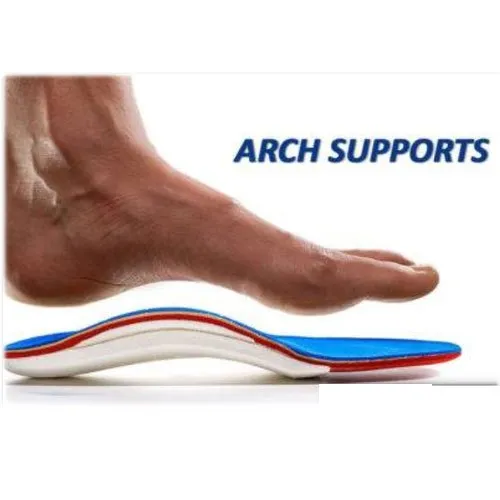
Cost Considerations and Accessibility
- Affordability of Treatments: Various treatments for foot conditions, including orthopedic insoles, physical therapy, or specialized footwear, come with associated costs. Orthopedic insoles, for instance, vary in price depending on the type, customization, and brand. Some may be more affordable than others, while custom-made options might be more expensive but tailored to specific needs.
- Insurance Coverage: Depending on your health insurance coverage, some treatments for foot conditions may be partially or fully covered. Orthopedic insoles or visits to a podiatrist may be reimbursable under certain insurance plans, reducing out-of-pocket expenses.
- Accessibility of Specialists: Access to podiatrists or specialists trained in foot care might vary based on location. Rural areas or regions with limited healthcare facilities might have reduced accessibility to specialized foot care services, impacting treatment options.
- Over-the-Counter Solutions: Some over-the-counter options for foot conditions, such as generic orthopedic insoles or basic supportive footwear, might be more accessible and affordable. While they may not offer the same level of customization, they can still provide some relief.
- Community Health Programs: Some communities or healthcare facilities offer programs or clinics providing subsidized or free foot care services, including screenings, consultations, or basic treatments. These programs aim to improve accessibility to foot health services for individuals with limited financial means.
- Cost-Effectiveness in the Long Run: While certain treatments or specialized footwear might seem more expensive initially, they can be cost-effective in the long run by preventing the worsening of foot conditions, reducing the need for extensive medical interventions, or avoiding complications.
- Researching Options: Exploring different brands, types, and available treatments can help find more affordable options without compromising on quality or effectiveness. Additionally, discussing cost concerns with healthcare providers or specialists might lead to recommendations for more budget-friendly solutions.
Considering cost and accessibility factors is crucial in finding suitable treatments for foot conditions like plantar fasciitis. Exploring various options, understanding insurance coverage, and seeking advice from healthcare professionals can aid in making informed decisions that balance effectiveness with affordability.
Myths and Misconceptions About Orthopedic Insoles
- Myth: Orthopedic insoles are only for elderly individuals or those with severe foot problems. Fact: Orthopedic insoles cater to various foot conditions and activity levels. They’re beneficial for people of all ages and can prevent issues by providing support and proper alignment.
- Myth: Orthopedic insoles are uncomfortable and difficult to get used to. Fact: Initially, there might be an adjustment period, but most people adapt quickly. Modern orthopedic insoles are designed for comfort and come in various materials to suit different preferences.
- Myth: Generic insoles from stores offer the same benefits as orthopedic insoles. Fact: Orthopedic insoles are custom-designed or tailored for specific foot issues, providing targeted support that generic insoles might not offer. Customization enhances their effectiveness.
- Myth: Orthopedic insoles are a one-size-fits-all solution. Fact: Orthopedic insoles come in various types catering to different foot shapes, arch types, and conditions. Customization ensures they address individual needs more effectively.
- Myth: Orthopedic insoles can completely cure foot problems like plantar fasciitis. Fact: While orthopedic insoles provide significant relief and aid in managing conditions, they might not completely cure underlying issues. They are part of a comprehensive treatment plan.
- Myth: Once pain subsides, you can stop using orthopedic insoles. Fact: Consistent use of orthopedic insoles might be necessary for ongoing foot health. Discontinuing their use abruptly might lead to a recurrence of discomfort or foot problems.
- Myth: Orthopedic insoles are expensive and not worth the investment. Fact: While some orthopedic insoles can be pricier, they are often a worthwhile investment in foot health. They can prevent worsening conditions, reduce pain, and potentially lower healthcare costs in the long run.
- Myth: Orthopedic insoles are only for athletes or those engaged in intense physical activities. Fact: Orthopedic insoles benefit anyone needing foot support, including individuals with everyday jobs or lifestyles. They aid in preventing issues caused by prolonged standing or walking.
Understanding these myths and clarifying misconceptions can help individuals make informed decisions about using orthopedic insoles. Consulting with a podiatrist or footwear specialist can provide tailored advice and dispel any uncertainties regarding their usage and benefits.
Real-life Success Stories
- John’s Story: John, an avid runner, struggled with persistent heel pain due to plantar fasciitis. After trying various treatments, he opted for customized orthopedic insoles. Within weeks of consistent use, he noticed a significant reduction in pain. Gradually, he resumed running and completed a marathon, attributing his success to the support provided by the insoles.
- Sarah’s Experience: Sarah, a nurse on her feet for long shifts, battled with severe foot discomfort. She started using orthopedic insoles designed for healthcare professionals. The insoles’ shock-absorbing properties and arch support alleviated her pain, allowing her to perform her duties comfortably, improving her overall work experience.
- Mark’s Relief: Mark, a teacher experiencing chronic foot pain, was skeptical about orthopedic insoles initially. However, after trying a pair specifically crafted for his flat feet, he experienced immense relief. The insoles provided the necessary arch support, reducing his discomfort during standing periods while teaching.
- Emily’s Transformation: Emily, a retail worker, faced excruciating heel pain daily. Custom orthopedic insoles recommended by her podiatrist transformed her experience. Within a few weeks, she noticed a remarkable improvement, enabling her to continue her job without constant discomfort.
- David’s Recovery: David, a middle-aged individual with plantar fasciitis, struggled with limited mobility. He incorporated orthopedic insoles into his daily routine and combined them with physical therapy. Over time, he regained mobility, significantly reducing his reliance on pain medications.
- Lisa’s Active Lifestyle: Lisa, an active retiree, had to limit her activities due to foot pain. Orthopedic insoles designed for her specific activity level allowed her to resume hiking and gardening, enhancing her overall quality of life.
These real-life success stories showcase the positive impact of orthopedic insoles on individuals dealing with foot conditions like plantar fasciitis. Their testimonials highlight the relief, improved mobility, and regained comfort that these insoles can provide, enabling individuals to pursue their passions and daily activities with reduced pain and discomfort.
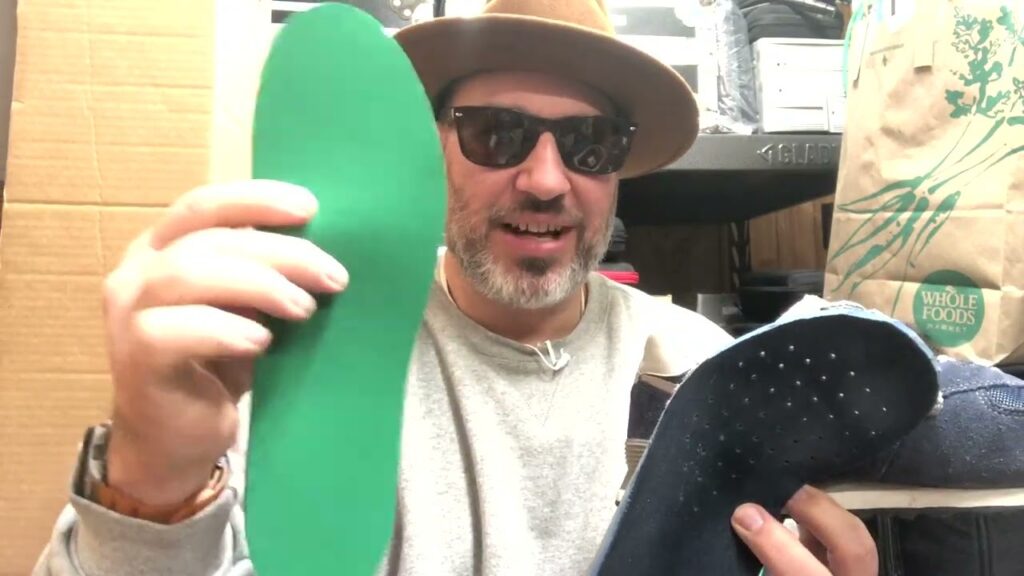
Professional Advice and Consultation
- Accurate Diagnosis: Podiatrists specialize in diagnosing and treating foot conditions. Consulting them ensures accurate identification of the issue causing discomfort or pain, allowing for appropriate treatment recommendations.
- Customized Solutions: Podiatrists can provide personalized recommendations tailored to individual foot structure, gait patterns, and specific conditions. This customization ensures that orthopedic insoles or treatments address the root cause effectively.
- Understanding Treatment Options: Podiatrists offer comprehensive insights into various treatment options beyond orthopedic insoles. They can discuss alternative therapies, exercises, lifestyle modifications, and potential footwear changes suitable for each individual.
- Proper Fit and Selection: Footwear specialists or podiatrists can guide you in selecting the right orthopedic insoles based on your foot type, activity level, and condition severity. They ensure a proper fit and advise on the most suitable type of insole for your needs.
- Monitoring Progress: Professionals can monitor your progress, making necessary adjustments to treatment plans as needed. Regular check-ups help track improvements and ensure that the chosen treatment, including orthopedic insoles, remains effective.
- Preventive Care: Podiatrists not only treat existing conditions but also offer preventive care advice. They can suggest strategies to maintain foot health and prevent potential issues in the future.
- Insurance Coverage: In some cases, consultation with a podiatrist or specialist might be covered by health insurance. This can reduce the financial burden associated with seeking professional advice.
- Expert Guidance: Podiatrists have extensive knowledge and expertise in foot health. Their guidance can clarify any doubts, dispel myths, and provide you with a comprehensive understanding of your foot condition and available treatment options.
Consulting a podiatrist or footwear specialist ensures that you receive accurate diagnosis, personalized treatment plans, proper guidance in selecting orthopedic insoles, ongoing monitoring, and comprehensive foot care advice, leading to improved foot health and overall well-being.
Future Innovations in Orthopedic Insoles
- Smart Insoles: Integrating technology like sensors and pressure mapping into insoles allows real-time tracking of foot pressure distribution and gait analysis. Smart insoles can provide valuable data for personalized treatment plans and better customization.
- 3D Printing Technology: Advancements in 3D printing enable the creation of highly customized orthopedic insoles based on precise foot scans. These insoles are tailored to individual foot anatomy, optimizing comfort and support.
- Material Innovations: Research is exploring new materials that enhance cushioning, support, and durability of orthopedic insoles. These materials offer improved shock absorption, temperature regulation, and moisture management for better overall foot health.
- Biomechanical Adaptation: Future insoles may dynamically adapt to changes in foot movement or pressure, providing responsive support that adjusts to various activities and foot positions.
- Regenerative Insoles: Bioengineered insoles may incorporate regenerative properties, utilizing materials that stimulate tissue repair and healing, potentially aiding in recovery from foot injuries or conditions.
- Energy Harvesting Insoles: Insoles that harness energy from the wearer’s movement could power embedded sensors or devices, making smart insoles self-sustaining and enhancing their functionality.
- Customization and Personalization: Innovations will focus on more accessible and cost-effective methods for creating highly personalized insoles, using technologies that capture precise foot measurements and individual requirements.
- Therapeutic Insoles: Insoles embedded with therapeutic elements like targeted massage functionalities or temperature control to alleviate pain and enhance foot comfort are also being explored.
- Enhanced Integration with Footwear: Future insoles might integrate seamlessly with various types of footwear, ensuring compatibility and optimizing their effectiveness across different shoe styles.
These anticipated innovations in orthopedic insoles hold immense promise for improving foot health, offering more precise and tailored solutions for individuals with foot conditions like plantar fasciitis or those seeking enhanced comfort and support. As technology evolves, these advancements aim to provide more effective and accessible foot care options for everyone.
Conclusion
Orthopedic insoles stand as an accessible and effective remedy for alleviating the discomfort associated with plantar fasciitis, offering not just relief but also support in everyday life.
FAQs About Orthopedic Insoles for Plantar Fasciitis
- Are orthopedic insoles suitable for all types of foot arches?
- Can orthopedic insoles completely cure plantar fasciitis?
- How long should one wear orthopedic insoles in a day?
- Do orthopedic insoles work for other foot conditions apart from plantar fasciitis?
- Are custom-made orthopedic insoles significantly better than over-the-counter options?




